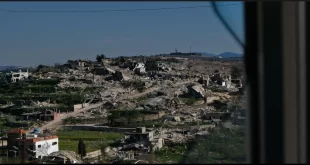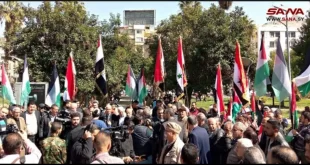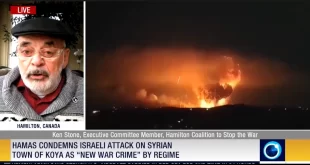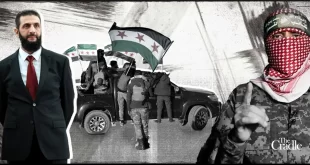The following article by Aaron Maté is republished from The Grayzone:
In remarks to the UN Security Council, The Grayzone’s Aaron Maté details the OPCW’s Douma cover-up scandal and urges UN members to support the chemical watchdog’s inspectors whose evidence was suppressed.
At an Arria-Formula Meeting of the United Nations Security Council, Aaron Maté of The Grayzone delivers remarks on the OPCW’s ongoing Syria scandal.
Veteran OPCW inspectors who investigated an alleged chemical attack in Douma, Syria in April 2018 say that their probe was censored and manipulated. Under direct US government pressure, the OPCW concealed evidence that pointed to the incident being staged on the ground, and instead released a report that suggested Syrian government culpability. The allegation against Syria led to the bombing of Syria by the US, France, and UK just days after the alleged Douma incident. In his remarks, Aaron calls this “one of the most important, and overlooked, global stories in recent memory” and urges the UN and OPCW to let the OPCW inspectors air their concerns, and present the evidence that was suppressed.
Other briefers participating in the UN session were former OPCW inspector Ian Henderson, a member of the Douma team; and award-winning physicist Ted Postol, MIT professor emeritus and former Pentagon adviser.
The full video of the UN session can be viewed here.
TRANSCRIPT
Excellencies, ladies and gentlemen,
My name is Aaron Maté. I am a journalist with The Grayzone, based in the United States. It’s an honor to speak to you today about what I think is one of the most important, and overlooked, global stories in recent memory.
The OPCW — the world’s top chemical weapons watchdog — is facing a serious scandal. Leaks from inside strongly suggest the OPCW has been severely compromised. The implications of this are grave.
It would mean that the OPCW was exploited to accuse the Syrian government of a chemical weapons attack in the city of Douma in April 2018. It would also mean that the OPCW was used to retroactively justify the bombing of Syria by several member states, just days after the alleged Douma incident. In short, it appears the OPCW was compromised to justify military strikes.
There are also indications that the OPCW has retaliated against two veteran officials who were part of the Douma investigation and challenged the censorship of the Douma evidence.
These two OPCW officials are highly regarded scientists with more than 25 years of combined experience at the organization. Yet instead of being protected, and given the chance to air their concerns, these two scientists have seen their reputations impugned by the OPCW leadership.
There is substantial evidence to back all of this up. I will summarize the key details.
The OPCW’s Fact-Finding Mission, or FFM, deployed to Syria and what is known as Country X to investigate the Douma incident in April 2018. They interviewed scores of witnesses and visited several key sites. They examined gas cylinders found at the scene, took chemical samples and hundreds of photos, and conducted detailed measurements.
Upon their return from Syria, the FFM team drafted an extensive and detailed report of their findings. But what the investigators found in Douma is not what the OPCW released to the world. And that is because the investigators who were on the ground in Syria were overruled, and had their findings censored.
The key facts about this censorship are, to my knowledge, undisputed:
1) The investigators’ initial report, which was due for imminent publication, was secretively re-edited to produce a version that sharply deviated from the original. Both versions – the original and the altered report – have been published by Wikileaks.
Comparing both reports we see that key facts were removed or mis-represented. Conclusions were also rewritten to support the allegation that a chlorine gas attack had occurred in Douma.
Yet the team’s initial, original report did not conclude that a chemical attack occurred. In fact, their report had presented the possibility that victims in Douma were killed in an incident that was “non-chemical related.” Though unstated, the reader could easily infer from this that the militants who controlled Douma at the time had staged the scene to make it falsely appear that a chemical attack had occurred.
2) Then there is the toxicology assessment. Four experts from an OPCW and NATO-member state conducted a toxicology review.
They concluded that observed symptoms of the victims in Douma, “were inconsistent with exposure to chlorine, and no other obvious candidate chemical causing the symptoms could be identified.”
This finding was kept secret, and are inconsistent with the conclusions of the final report.
3) There were also chemical tests of the samples collected in Douma. These samples showed that chlorinated compounds were detected at what amounted to trace quantities in the parts-per-billion range.
Yet this finding was also not disclosed. Furthermore, it later emerged that the chemicals themselves did not stand out as unique: most, if not all, could have resulted from contact with household products such as bleach — or come from chlorinated water or wood preservatives.
Crucially, the control samples collected by the inspectors to give context to the analysis results were never analyzed.
4) Because of other leaks, we now know that this censorship was protested from the inside. The chief author of the initial report, identified by the OPCW as Inspector B, was among those who deployed to Syria for the entire Douma mission. Records show he was also, at the time, the OPCW’s top expert in chemical weapons chemistry.
On June 22nd, 2018 Inspector B protested the secretive redaction in an e-mail expressing his “gravest concern.” I will quote him: “After reading this modified report, which incidentally no other team member who deployed into Douma has had the opportunity to do, I was struck by how much it misrepresents the facts.”
5) After that e-mail of protest, and just days before a substitute, stop-gap interim report was published on July 6, something very unusual occurred. A US government delegation met with members of the investigation team to try to influence them. The US officials encouraged the Douma team to conclude that the Syrian government had committed a chemical attack with chlorine. It is worth noting here that the US delegation promoted this chlorine theory despite the fact that it was still not publicly known that no nerve agents had been found in Douma.
The Douma investigators reportedly saw the meeting as unacceptable pressure and a violation of the OPCW’s declared principles of independence and impartiality. Under the Chemical Weapons Convention, State Parties are explicitly prohibited from seeking to influence the inspectors in the discharge of their responsibilities.
6) Inspector B’s intervention thwarted the imminent release of the doctored report.
But at that point, the OPCW officials began to manage the issuance of a new negotiated report, namely, the so-called interim report that was released on July 6 2018.
Although this interim report no longer contained some of the unsupported claims that senior OPCW officials had tried to insert, it still omitted key facts found in the original, uncensored report.
7) Around that time, the investigation saw a drastic change. The protesting Inspector B – who had written the original report — was sidelined from the investigation. OPCW executives then decreed that the probe, from that point forward, would be handled by a so-called “core team.”
This new “core” team made formal the exclusion of all of the inspectors who had conducted the investigation in Syria, except for one paramedic. It was this so-called core team—and not the inspectors who had signed off on the original report—that generated the OPCW final’s report of March 2019.
8) That final report sharply differed from what the OPCW inspectors reported in the suppressed initial report. The final report concluded that there were “reasonable grounds” to believe that a chemical weapons attack occurred in Douma and that “the toxic chemical was likely molecular chlorine.” Many crucial facts and evidence redacted from the original report continued to be omitted.
9) The final report also saw a major discrepancy when it comes to witness testimony. The witnesses interviewed offered sharply contrasting narratives – yet only those witnesses whose testimony supported the use of chemical weapons, were used to inform the report’s conclusions.
It is also worth noting the imbalance in witness locations: although the alleged chemical incident took place in Syria, twice as many witnesses were interviewed in Country X.
10) One inference drawn from the OPCW’s final report was that gas cylinders found in Douma likely came from military aircraft. But a leaked engineering assessment assigned to a sub-team of the FFM found otherwise.
The OPCW leadership has yet to offer a substantive explanation for why such critical evidence was excluded and why the original report was radically altered.
The OPCW Director General Fernando Arias justified the conclusions of the final report and excused alleged fraudulent scientific behavior by incorrectly stating that “the FFM undertook the bulk of its analytical work” during the last seven months of the investigation – or after the interim report that was published in July 2018.
A close review of the final report demonstrates that this is far from the case. As the dissenting inspectors have noted, by the time the interim report was released, 31 of the 44 samples were analyzed, 34 of the 39 interviews had been conducted and analyzed, and the toxicological study was already done but the conclusions excluded.
In the nearly eight months after the Interim Report was released, only 13 new samples were analyzed along with 5 additional interviews.
Comparing the text of the final report to the original report is also instructive. The final report copy and pastes much of the text of the original report – the one difference is that inconvenient evidence was removed, and un-supported conclusions were added.
But even if it were true that the bulk of the analysis was done after the interim report, the fact the OPCW would have conducted the bulk of its work after July 2018 would not in any way explain or justify the alleged scientific fraud committed before it. In fact, it would only raise the possibility that more fraud occurred.
Instead of addressing the discrepancies and cherry-picked facts, the OPCW Director General Fernando Arias has also denigrated the two members of the Douma fact-finding mission team who challenged the manipulation of facts and evidence.
The Director General has falsely portrayed them as rogue actors, with only minor roles in the investigation and incomplete information.
Yet these two inspectors are unlikely candidates to suddenly go so rogue. Inspector A has been identified as Ian Henderson – he is here today. The second inspector is known only as Inspector B. They served with the OPCW for 12 and 16 years, respectively.
Internal OPCW appraisals of their job performance offer effusive praise. In 2005, a senior OPCW official wrote that Henderson has consistently received “the highest rating possible.… I consider [him] one of the best of our Inspection Team Leaders.”
In 2018, an OPCW superior wrote that Inspector B, “has contributed the most to the knowledge and understanding of Chemical Weapons chemistry applied to inspections.” Another manager described B as “one of the most well regarded” team leaders, whose “experience of the organisation, its verification regime, and judgment are unmatched.”
It is important to also stress that the internal concerns go beyond Douma team members. Earlier this year, I heard from an OPCW official who voiced outrage at the treatment of Henderson and Inspector B. I quote this person now:
“It is quite unbelievable that valid scientific concerns are being brazenly ignored in favour of a predetermined narrative. The lack of transparency in an investigative process with such enormous ramifications is frightful. The allegations of the two gentlemen urgently need to be thoroughly investigated, and the functionality of the organisation restored.”
Now fortunately, the two inspectors involved in this Douma controversy have offered a path to transparency and to resolving this scandal. Earlier this year, they each wrote letters to the OPCW Director General asking for their concerns to be heard.
The inspectors have received support from several prominent figures, including the OPCW’s First Director General, Jose Bustani. In October 2019, Bustani took part in a panel that heard an extensive presentation from one of the Douma investigators.
Mr. Bustani wrote: “The convincing evidence of irregular behaviour in the OPCW investigation of the alleged Douma chemical attack confirms doubts and suspicions I already had. I have always expected the OPCW to be a true paradigm of multilateralism. My hope is that the concerns expressed publicly by the Panel, in its joint consensus statement, will catalyse a process by which the Organisation can be resurrected to become the independent and non-discriminatory body it used to be.”
I hope that Mr. Bustani’s words will be heeded. As a first step, the OPCW can simply do what it has refused to do so far: meet with the entire Douma team, and let them present the evidence that was censored. It is very concerning that despite the allegations here, the OPCW Director General has never met with members of the Douma team – not just the two dissenting inspectors that are known, but the entire team. If the OPCW is confident in its conclusions, then it should have no issue with at least hearing a dissenting point of view.
The importance of addressing this issue extends far beyond repairing the OPCW’s reputation. Syria is a country that is now trying to rebuild from a devastating, nearly decade-long proxy war that caused massive suffering, destruction and death. But as Syria is trying to rebuild, it now faces a new kind of warfare in the form of crippling economic sanctions. In justifying the sanctions, the US government has cited, among other things, allegations of chemical weapons use by the Syrian government. The US government also says that the Syrian government is the target of these sanctions. But it is the Syrian people who feel the pain. The UN rapporteur on sanctions says that, “unilateral sanctions applied to Syria have visited untold sufferings on ordinary people.” The World Food Program warns that Syrians living under economic blockade now face “mass starvation or another mass exodus.”
The use of the OPCW to justify warfare on Syria – whether in the form of military strikes in 2018 or economic strangulation today in 2020 – is additionally tragic in light of the OPCW’s own history. It was just seven years ago that the OPCW was awarded the Nobel Peace Prize for its work eliminating chemical weapons, including in Syria. That was a towering achievement, and a hopeful moment for those who seek a world at peace. How unfortunate then, to see the world’s top chemical weapons watchdog now potentially being comprised to lodge unproven allegations against Syria and justify warfare against it.
The OPCW inspectors who have been silenced and maligned are trying to defend their organization’s noble legacy from political exploitation. It is my hope that they will be heard. Thank you.
 Syria Support Movement solidarity with the Syrian people
Syria Support Movement solidarity with the Syrian people




